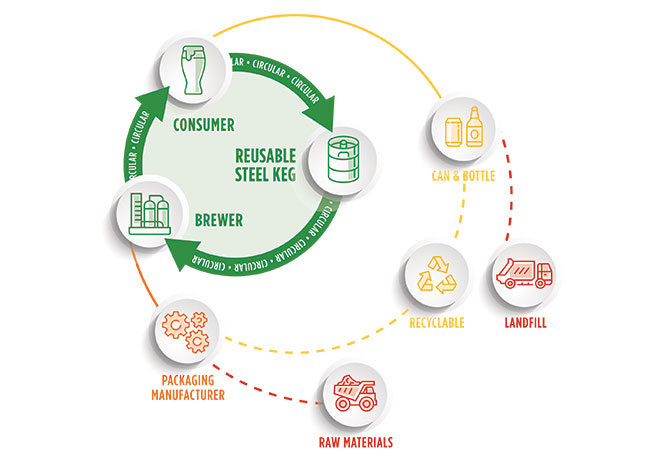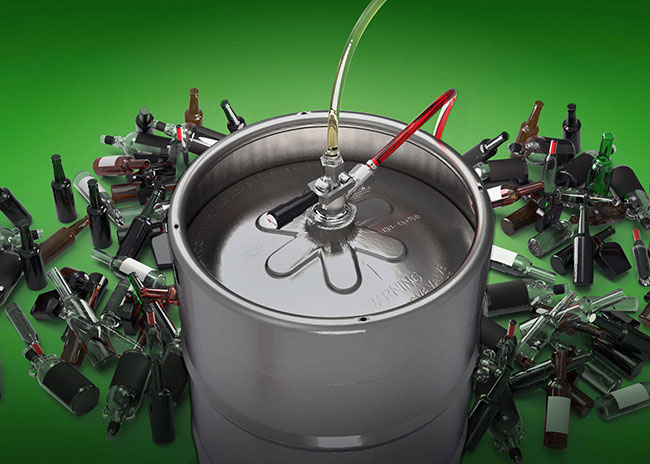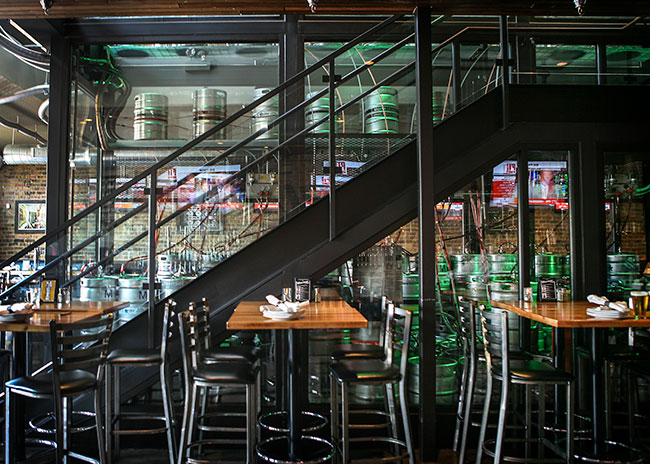Reusable Stainless Steel Kegs as the Sustainable Beer Packaging Choice
Customers are becoming more critical of businesses that aren’t taking sustainability seriously. Showing your customers that you care about their wellbeing — as well as the planet’s — has become an essential aspect of doing business.
There is no question that the topic of sustainability has become a lot more than a buzzword. The more you look into its meaning and necessity, the more compelling it is to look for ways to be kinder to our planet — and the beer industry is no exception. But how, exactly, are we looking for ways to achieve it?
An American History in Sustainable Beer Packaging
Our founding fathers' forward-thinking methodology of serving beer dates back to 1620, when they came over on the Mayflower. Departing from England in search of the New World for more than two months, the passengers and crew weathered storms, sickness, and starvation without taking to land—until they ran out of beer.
Even then, the draft beer keg had its rightful place as the ideal “on-premise” package serving and sustaining the 100-plus passengers aboard the ship. The famous ale that was shipped to India was also delivered in kegs and only transferred to bottles for the civilian middle class; the troops drank their beer the same way they drank it back home – dispensed right from the keg.
When you consider this history, you start to realize the value of the draft beer keg then and now. Even today, the draft beer keg remains at the forefront of function and sustainable beer packaging — it still has no equal! When stored and poured properly, draft beer can be one of the highest profit margin items. This is because profit margins can be up to 80%, and cost per ounce is up to 45% lower than beer in either a can or bottle.

There is no question the draft beer keg is the most environmentally responsible beverage package in the brewing industry today. Sustainable beer packaging matters because it ticks all the boxes. It is:
- Reusable
- Refillable
- Recyclable
But the benefits of steel kegs don’t stop with its monetary value…
Circularity
Circularity refers to keeping in mind where a product will end up once it has served its purpose. When it comes to cans and bottles, while they can certainly be recycled, the reality is that most consumers simply throw them away when they’re done drinking their beverage. Additionally, data from the U.S. Environmental Protection Agency (EPA) shows the low recycling rates for some key beverage containers, including glass beer and soft drink bottles (39.6 percent), glass wine and liquor bottles (39.8 percent), and aluminum beer and soft drink cans (50.4 percent). These low percentages prove there is ample need for change.

Stainless steel kegs, however, are reused for decades, exponentially reducing the amount of waste that reaches landfills. The draft beer keg has a service life of over 30 years. When you do the math, the average keg can serve 165 (12 ounce) bottles/cans; and turns five times per year; that means that over the life of a keg, about 25,000 glasses will be served from a single keg! Now multiply that by the number of kegs in a brewery, in a city, in a state, in the country, and worldwide – there is no question that the environmental impact is massive.
In fact, Dan Vorlage, Executive Director of the Steel Keg Association, states that “Kegs presently remove about half of all single-use beer containers from the bar/restaurant waste stream each year. That’s approximately 6 billion containers.” Check out the Steel Keg Association and their beer and sustainability mission here.
 Over the 30-year lifespan of a keg, over 25,000 cans/bottles will be saved from the land fill.
Over the 30-year lifespan of a keg, over 25,000 cans/bottles will be saved from the land fill.
Consequently, the industry reduces its CO2 emissions and carbon footprint compared to single-use packaging, because kegs require fewer production and transportation resources. Studies suggest a keg used over 20 times boasts a lower environmental impact than single-use containers. And once they’ve reached the end of their lifespan, the materials are used to create new kegs.
There is a bill that further addresses sustainability in the beer segment. Introduced by Representatives Darrin LaHood (R-IL) and Steve Horsford (D-NV) the Creating Hospitality Economic Enhancement for Restaurants and Servers (CHEERS) Act is a proposed bipartisan bill that will support local bar and restaurant establishments by incentivizing the expansion of tap lines and keg equipment on commercial premises. This also will extend accelerated tax benefits for qualifying investments into energy-efficient systems. This bill not only will help expand on technology but also provide additional sustainability options for businesses. Learn more about the CHEERS Act.
Efficiency and Profitability
Draft beer profits play a significant role in the overall profitability of every bar and restaurant. Along with sustainable beer packaging’s environmental benefits, the stainless steel draft beer keg is the most profitable on-premises package available today; for retailers, draft beer's economic, high-margin profile ensures a maximum return on investment (check out our draft beer profitability calculator). They are among the best products to increase same-store sales and boost the average cost per check. And while this alone is enough to make the investment worth it, it’s also important to note that this storage method can be used for much more than beer. Kegs offer a practical solution whether you serve brews, wine, cocktails, kombucha, or nitro cold brews on tap.
An Improved Customer Experience
Kegs are designed to store beverages in a way that preserves optimal freshness, quality, and taste. As a starting point, this keeps customers happy. It also keeps them returning for more and bringing along their friends and families.
With the popularity of craft and microbrew beers, offering seasonal brews on tap provides differentiation and choice. Consider the number of operators promoting specialty beers to complement the demand for expanded food options. There is no doubt that today's consumers want choice, and with the variety of seasonal and craft draft beers on the market, specialty draft beers are the ideal fit to assist in raising sales and profitability.
 At some restaurants/breweries, the keg system can make for a unique design element.
At some restaurants/breweries, the keg system can make for a unique design element.
Draft beer is the ideal sampling tool for the brewery to promote new products and increase brand awareness. With the numerous brand choices available today, each tap handle offers a unique opportunity to gain visibility and trial in the brewer’s quest to build brand recognition.
And if you’re concerned that storing beverages exclusively in kegs means being limited with what you can serve, think again. Modern stainless steel options offer a wide variety of beverage alternatives.
An Environmental Evolution
A growing number of bars and restaurants are focusing on sustainability due to customer preferences and because these businesses realize the benefits to the environment and their bottom line. This has become even more vital due to the evolving beer segment.
The average bar or restaurant in the 1960s served four draft beers—two domestic and two imports—from a simple refrigerated direct draw draft beer system. Today, the number of beers on tap can reach 40+, with many outlets featuring regional beers to take advantage of the successful trend toward seasonal, craft, and microbrew beers.
As a result, the glycol-cooled long-draw system has become the industry's standard to satisfy the operators' need to serve a wide range of choices and the coldest and best beer in town. This is one of the most popular draft beer systems and is an excellent choice due to its ability to maintain the cooler temperature and deliver cold beer at long distances.
Integral to the improved performance of the glycol system is the use of blended gas (CO2 and nitrogen) as the primary pressure source. Using blended gas preserves draft beer quality and offers the benefit of consistent pour quality from the first glass to the last glass — minimizing waste and maximizing keg yields for a more sustainable pour.
Maximizing Sustainable Beer Packaging
Sustainable beer packaging offers a number of benefits, ranging from maximizing profits, improving the customer experience and reducing a company’s carbon footprint.
From a labor standpoint, draft beer programs provide efficiency, speed of service and the ability to expand offerings and rotate menus as needed. With these systems, bars and restaurants also can easily expand sampling programs, which leads to increased revenues.
With the thousands of macro and craft beer now being offered, not taking advantage of the draft beer potential means not capitalizing on a sustainable beer packaging opportunity that could take your business to the next level.



